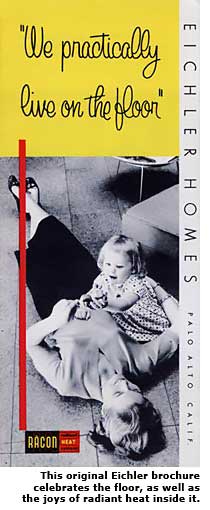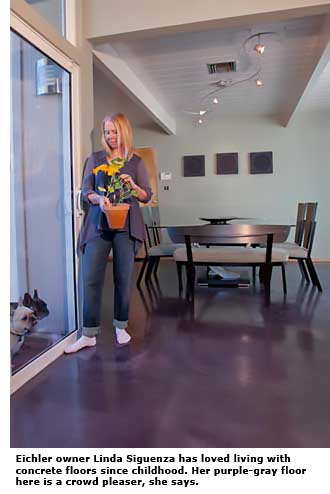Cool, Cool Concrete

If you want ultra-modern style and major design impact, consider concrete floors -- the flooring for the hip at heart.
There are good reasons why interior designers often choose concrete for their most modern spaces. Stained, colored, textured or smooth, concrete boasts limitless design options. It provides a blank canvas upon which homeowners can leave their mark.
But beyond the design advantages, these surfaces are low maintenance and they blend seamlessly with the architectural aesthetics of mid-century modern homes.
Eichler owner Linda Siguenza wouldn't have it any other way. She loved the concrete floors in her childhood Eichler so much that she opted for concrete when she purchased her current residence in the San Mateo Highlands.
"We wanted a super-modern look -- and like my freckles, my concrete floors help to camouflage wear as it gets older," she laughs.

Siguenza chose a deep-purple-and-gray-mist concrete floor that plays beautifully against her red-birch cabinetry. She says the bold color choice has been a crowd pleaser on her neighborhood's home tour for several years.
Not everyone has had as much luck with concrete, however. When John Klima and his family moved into their 1958 Jones and Emmons Eichler in Lucas Valley's Marinwood in 2007, they never anticipated that concrete floors could become a remodeling disaster. "Our concrete floors have become a multi-year, multi-step problem," Klima says.
When the Klimas arrived, their home's floors were covered in a hodgepodge of surfaces. Three bedrooms were overlaid with carpet; two rooms with laminate; and the hallways, kitchen, and baths featured an outdated 12-inch tile.
"We really wanted as continuous a floor as possible," Klima says, "and something that would be smooth and durable." The Klimas' initial surface preference was large-format porcelain tile, but it proved to be too expensive, so they opted instead for a smooth concrete floor. They also decided to leave the original tile in the kitchen and bathrooms to simplify the scope of the flooring project.
When Klima contacted a floor refinisher to wet-grind his floors, the goal was to take the surface to a 70-grit finish and seal the floors with a clear acrylic sealer. This project cost $5,800. Unfortunately, just hours after applying the first round of clear coat, a white powder appeared.
"Turned out it was a bad idea to grind the floors," Klima says. "No one can really tell me why, but when we wet-ground them, we woke them up. It looked like when you see a puddle of water start to freeze over. You could see the layer of epoxy just bubble and lift right off. My wife said it was the ugliest floor you could come up with -- worse than the worst garage."
The white powder is efflorescence -- a condition in which soluble salts and other minerals enter concrete and mortars from below and settle on the surface. Low temperatures and moisture commonly accompany its appearance.

Klima then contacted concrete specialist Blaine Quillen of Creations in Concrete, based in Sacramento, to troubleshoot the problem by applying overlays.
Quillen says the problem Klima experienced with his floor is a common one, but usually to a lesser degree, with Eichler concrete slabs impacted by underlying moisture issues. In Lucas Valley, where the Klimas live, runoff water tends to gather at the base of the steep hills, where many homes stand. Minerals and moisture seep through the soil and permeate the concrete. Once Klima grounded away the mastic from the concrete, the white efflorescence came to the surface.
Quillen had learned the art of concrete overlays from friend Mike Miller, owner of The Concretist, Inc., a Benicia-based association of artists and craftsmen who produce concrete art and architecture. Over a ten-year association, Quillen and Miller worked together on concrete flooring projects ranging from malls to museums, from Florida to New York. Soon afterwards, Quillen began his own concrete projects on the West Coast.
Despite Quillen's experience, Klima's concrete floor proved to be a tough challenge. Quillen applied acrylic and later concrete overlays, but each time efflorescence prevented the coating from sticking. Even after the messy process of overlay removal that followed, and the application of two additional chemicals, efflorescence returned.
Then, last December, Quillen tested a vapor seal epoxy in Klima's daughter's room. The product, which Quillen calls his "trade secret," seems to have worked.




